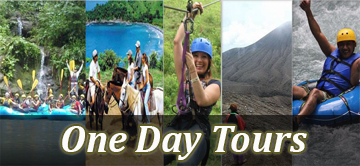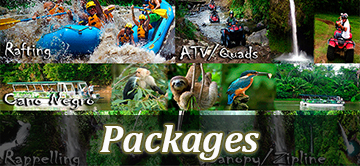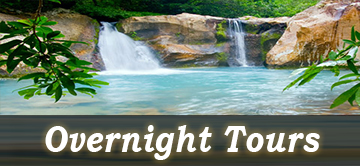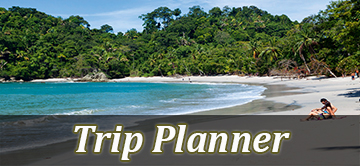Costa Rica is unquestionably one of the most popular vacation destinations around the world. It is certainly one of the most exotic places to visit as it offers travelers an astounding varied topography through out its territory. From hot sandy beaches to primary cloud forests, rainforests and active volcanoes, this beautiful country attracts over two million visitors every year.
Costa Rica is located on the Central American isthmus, bordering both the Caribbean Sea (Atlantic Ocean) to the east and the Pacific Ocean to the west. It also borders Nicaragua (to the north) and Panama (to the southeast).
Below you may find a complete range of Costa Rica maps, San Jose Costa ricamaps and other types of maps for Costa Rica divided in different categories:
Costa Rica Climate map: provides general information about the weather and precipitation of the country.
Economic map: shows the type of natural resources or economic activities in the Costa Rica.
Physical map: illustrates the mountains, volcanoes, rivers, lakes and beaches throughout Costa Rica.
Political map: indicates provinces, national boundaries and the country’s capital and major cities.
Costa Rica Road map: features main highways and roads, airports, railroad tracks, cities and points of interest in each region. You will also find distances and driving times to the main attractions.
Map of Provinces: provides information of provinces(States), limits, roads and attractions.
Touristic areas: These maps show detailed information about specific details that visitors may require for planning their vacation.
Explore different maps for Costa Rica below when planning your next Costa Rica vacation.
Costa Rica Physical Geography
Costa Rica’s territory is plain with extensive mountainous areas – including the Talamanca Mountain Range and the Central Mountain Range. The rugged mountains form the spine of Costa Rica, separating the Caribbean and Pacific coasts.
Costa Rica’s Mountain Ranges
Tilarán Mountain Range
The Tilaran Range is located in Abangares, Guanacaste, starting on the east side of Lake Arenal, near the Arenal Volcano. At the fringe of this mountain range is Monteverde, one of the most popular eco-tourism destinations in the country.
Central Mountain Range
The Central Mountain Range, known as the ‘Cordillera Central’, follows the Continental Divide east of Tilarán Mountain Range. Four important volcanoes comprise the range – Poás, Barva, Irazú and Turrialba.
Guanacaste Mountain Range
This range is located in the northern province of Guanacaste and is part of the Continental Divide’s southern region. Its highest peak is Miravalles Volcano (2,028 meters).
Talamanca Mountain Range
Most of the Talamanca Mountain Range is located within La Amistad International Park, which is part of Costa Rica and Panama.
Escazú Hills
The Escazú Hills is part of the northern portion of the Talamanca Mountain range, bordering the Central Valley to the south.
Costa Rica’s Weather and Ecology
Being part of the Neotropic ecozone, Costa Rica has two climates – tropical and subtropical. Costa Rica is also part of different eco-regions, including seasonal moist forests, dry forests, mangroves and small islands in the Pacific.
Costa Rica’s Natural Resources
Costa Rica’s electric production depends mostly on the country’s rivers and lakes – hydropower is about 80% of Costa Rica’s energy. Electricity is also generated by oil, geothermic energy, solar and wind power.
Costa Rica’s Protected Areas
Costa Rica’s national park system is administered by SINAC (National System of Conservation Areas), which protects the 26 national parks and more than 150 protected areas throughout the country. Apart from the country’s national parks, other types of protected areas are the following:
National Wildlife Refuges
Biological Reserves
Protection Zones
Absolute Nature Reserves
Costa Rica’s protected areas comprise over one-fourth of the country’s territory.
Tortuguero National Park
The Tortuguero National Park is one of the most important nesting sites in the world for marine turtles such as the giant leatherback turtles, the green sea turtles and the hawksbill turtles. From July to September, thousands of turtles come ashore along these world-famous beaches to lay their eggs. Tortuguero national park features 11 ecological habitats and allows a great diversity of fauna and flora to be observed close at hand. It is very common to find Spider Monkeys, Howler Monkeys and White Face Monkeys swinging through the trees, as well as hundreds of bird species and wildlife including Tiger Herons, Boas, Caimon’s, Tree Bats, Iguanas and more.
Environmental Treaties
Costa Rica has taken part in several environmental treaties including the following:
Convention on Biological Diversity
Montreal Protocol
Convention on Environmental Modification
Ramsar Convention
United Nations Framework Convention on Climate Change
Endangered Species Convention
International Convention for the Regulation of Whaling
Desertification Convention
Basel Convention
Convention on the Law of the Sea
Convention on Marine Dumping
Comprehensive Test Ban Treaty













